脱水机筒壁群孔加工组合机床设计
无需注册登录,支付后按照提示操作即可获取该资料.
脱水机筒壁群孔加工组合机床设计(cad图纸和论文说明书17000字)
摘 要
本论文详细介绍了组合机床的设计步骤,组合机床是一种高效率的专用机床,本广泛应用于机械制造行业,根据任务书的要求,我们本次设计的题目是:脱水机筒壁群孔加工的组合机床设计,钻削12-Ø5孔,总共432个,实行双工位加工。
本次毕业设计从零件分析入手,确定加工时的切削用量,根据相关公式计算出切削力,选择相应的液压滑台;计算出切削功率,选择动力箱和电动机;计算出切削转矩,选择合适的主轴直径和刀具。根据加工零件要求,绘制出组合机床的“三图一卡”,即被加工零件的加工工序图,加工示意图,组合机床尺寸联系图以及生产率计算卡。根据工件上孔的分布,设计出传动系统图,为检查各个零件间是否发生了干涉,绘制坐标检查图,最后绘制多轴箱总图。为了 保证零件在加工过程中准确定位,应设计一套夹具。
液压控制系统设计设计内容主要为明确设计要求,制定基本方案,绘制液压系统图,并且确定液压系统的主要参数,液压系统的主要参数包括载荷的组成和计算,计算液压缸的主要结构尺寸,对其它液压元件的选择具体以及专用件也给予慎重考虑。
根据脱水机筒壁群孔加工的工序的生产要求,批量,工艺特性,还需进行夹具的设计,由于工件简单,夹紧较方便,故采用手动装置,采用盖板螺旋压的夹紧方式,左右旋螺纹进行夹紧和松开,以便提高生产效率。
电气系统的设计就是运用机电传动的知识,即PLC系统进行控制,PLC控制系统有三菱,欧姆龙系统等。
关键词:组合机床 三图一卡 多轴箱 螺旋压紧夹具 PLC CAD
Abstract
This article detailed introduction makes up the design measure of the lathe .It is a kind of high –efficient special purpose lathe to make up the lathe ,is widely used in the mechanical manufacturing industry . According to the request of task book,to process a serious of holes , which is the tube of machine of dehydration and the diameter is 5. Originally design and stsrt with analysing the processing technology of the part ,determine the cutting quantity while processing ,calculate out the strength of cutting according to relevant formulace , calculate out the power of cutting as choosing the motive force case ,the basis of the electrical machinery ;calculate out and cut the torque,is elected the suitable diameter and cutter of main staft . Require according to processing of part , draw out and make up three pictures first calorie of lathe , Namely process into part process picture , processing sketch map ,lathe get in touch with size picture .and productivity calculate the card .According to the distribution of the hole on the work piece ,design the transmission picture .In order to interfere each other while checking every part ,express the outlines of various kinds of parts with different linear and colours .Draw out many axle case general drawing finally .For guarantee part accurate to confirm location clamp ,should design one retinue jig in processing .According to the actual conditions ,we design the spiral push mechanism of a set of drill .Draws the lathe and gets in touch with the size picture with finally .
According to dehydrates the cylinder wall group hole processing working procedure production request, the batch, the craft characteristic, but also must carry on the jig the design, because the work piece is simple, clamps conveniently, therefore uses the hand gear, uses the lap spiral spinning to clamp the way, about turns on lathe the thread to carry on clamps with the pine opens, in order to enhancement production efficiency.
The electrical system design is the utilization mechanical and electrical transmission knowledge, namely the PLC system carries on the control, the PLC control system has Mitsubishi, the ohm dragon system and so on.
Keywords Combinated-lathe Three picture and one card Many axle cases The spiral push mechanism PLC CAD
1 产品介绍
脱水机筒是工业用脱水机的关键组成部分,脱水机筒的质量优劣,直接关系到脱水机的性能优劣,因此,我们在设计前特地走访了沈阳皇姑区的一家工业脱水机的销售商,并认真听取了介绍。本产品采用不锈钢制,厚度为b=5,高H=400,外圆直径为Ø 1200.
2零件的功用以及技术要求
本次设计主要是加工脱水机筒壁的432- Ø5孔,组合机床双向进给加工,每次钻削12- Ø5孔,工作台旋转转位分度,每次5°,粗糙度保证6.3,工作台旋转误差不超过±0.5°,工件定位采取一面和短销定位,限制5个自由度。
3毛坯材料与制造方法的选择
根据实际生产情况和实际需要,本次设计脱水机筒壁的毛坯材料选择为不锈钢,采取模锻成型,后退火处理。
本次制造脱水机筒壁群孔加工采用组合机床双工位加工,可以提高生产率。
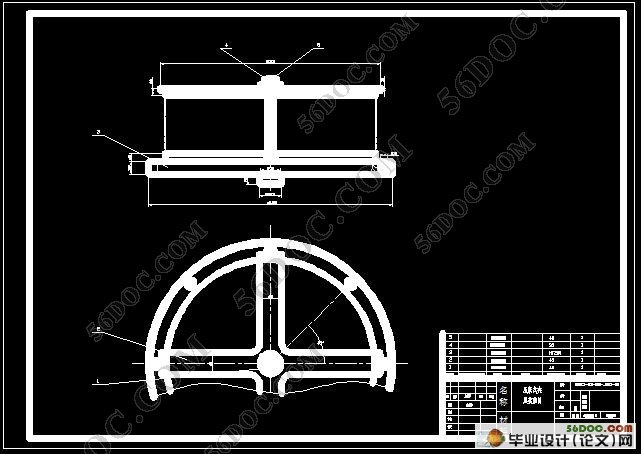
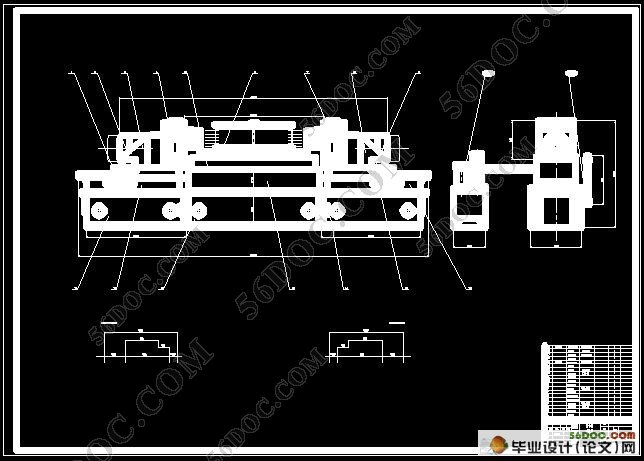
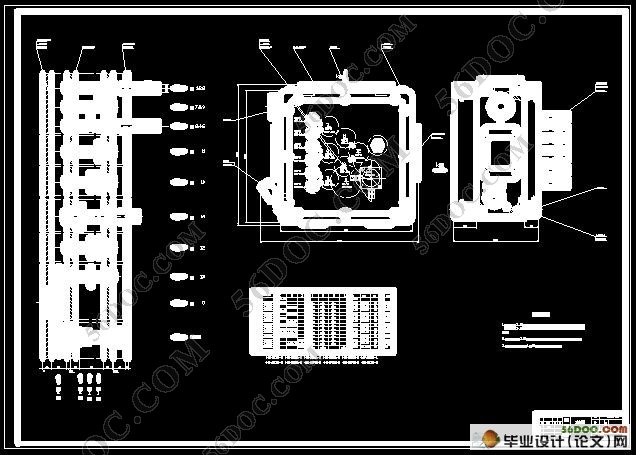
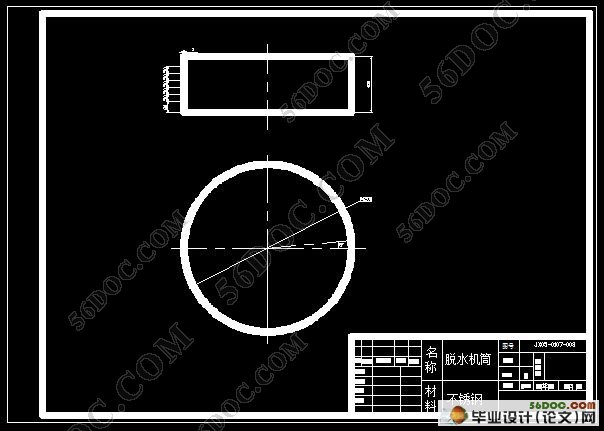

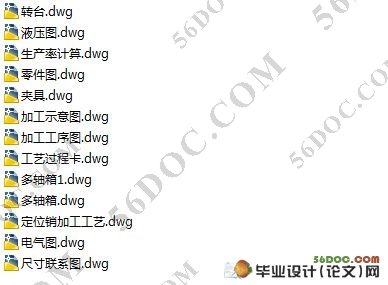
目录请看下一页
#p#副标题#e#
目 录
摘要…………………………………………………………………….…………1
Abstract……………………………………………………………………..……..2
前言……………………………………………………………………..……...3
第一 章 组合机床概述 ……………...……………………………………….…7
第二章 组合机床总体设计………………………………………………..….....8
2.1工艺方案的拟订……………………………………………………….….…..8
2.1.1产品介绍……………………………………………………………….…....8
2.1.2零件的功用以及技术要求……………………………………………….…8
2.1.3 毛坯材料与制造方法的选择. ………………………………...……….…...8
2.1.4 拟订工艺卡片………………………………………………………..….8
2.2 机床夹具设计…………………………………………………………..…9
2.2.1 机床夹具设计概述……………………………………………………...9
2.2.2 夹具设计基本要求……………………………………………………...9
2.2.3夹具设计的方案和步骤…………………………………………………9
2.3 切削用量的确定…………………………………………………………12
2.3.1 组合机床却削用量的确定………………………………………….....12
2.3.2 确定切削力,切削转速.切削功率以及刀具耐用度 ……………..…13
2.4 组合机床“三图一卡”…………………………………………………13
2.4.1被加工零件工序图…………………………………………………..……..13
2.4.2 被加工零件加工示意图……………………………………………………14
2.4.3 机床尺寸联系图 ………………………………………………….…..…...15
2.4.4 生产率计算卡…………………………………………………….……17
第三 章 组合机床多轴箱设计………………………………………….…18
3.1. 大型通用多轴箱的组成及其表达方法…………………………….…18
3.2 多轴箱通用零件…………………………………………………………18
3.2.1 通用箱体类零件………………………………………………….……18
3.2.2 通用主轴…………………………………………………………………86
3.2.3 传动轴的选择……………………………………………………………18
3.3 通用多轴箱设计…………………………………………………………........18
3.3.1 绘制多轴箱设计图以及原始依据图…………………………………….…18
3.3.2 主轴齿轮的确定以及动力计算…………………………………….….….. 19
3.3.3 多轴箱传动系统…………………………….…………………………….. 19
3.3.4 多轴箱坐标计算,绘制坐标检查图……………………………….…… …20
第四章 液压系统的设计计算…………………………………………………23
4.1. 液压缸设计计算步骤………………………………………….……….....23
4.2 液压缸性能参数计算………………………………………….……..........23
4.2.1 液压缸的输出力…………………………………………………………..23
4.2.2液压缸输出速度计算……………………………………………………...23
4.2.3 液压缸的作用时间……………………………………….…………….....24
4.3 液压缸的主要计算尺寸…………………………………………………….....25
4.3.1 液压缸的内径计算………………………………………………….…… …25
4.3.2 液压杆直径的计算………………………………………………….…….. ..25
4.3.3 液压缸行程的确定………………………….………………………. ……..25
4.4 结构强度计算以及稳定性校核……………………………………………26
4.4.1. 缸筒外径的确定………………………………………………………..26
4.4.2 液压缸的稳定性以及活塞杆的强度计算……………………………....26
4.4.3 液压缸的结构设计…………………………………………………..……27
4.4.4 液压传动系统设计…………………………………………………….…28
4.4.5 明确设计要求……………………………………………………………28
4.4.6 制定液压系统方案………………………………………………………....29
4.6 辅助装置的选择……………………………… ……………………….….…30
4.7 画出液压系统图……………………………… …………………………..…30
第五章 电气系统系统设计……………………………………………..…...31
5.1 电气设备概述……………………………………………………….….....31
5.1.1 PLC的基本组合………………………………………………...………..31
5.1.2 电气控制变压系统部分设计…………………………………….…..…....31
5.1.3电气控制的部分设计…………………………………… ………...……....31
5.2OMRON,CPM2A系列PLC功能介绍………………………………........33
5.3 部分设备的概述………………………………………………….………...34
5.3.1 选用和确定I/O设备…………………………………………….…...…...34
5.3.2选用PLC的型号以及参数分析…………………………………..…....34
5.4 控制程序设计…………………………………………………………....35
结论……………………………………………………………………...………..37
谢辞……………………………………………………………………….….…..38
参考文献与附录…………………………………….…………..…....…………...39
